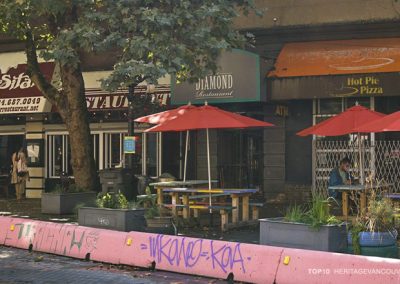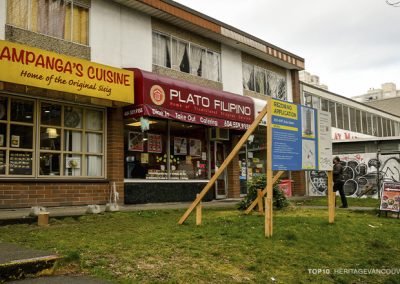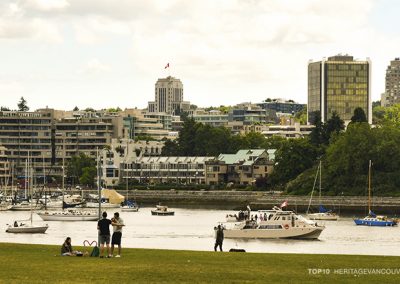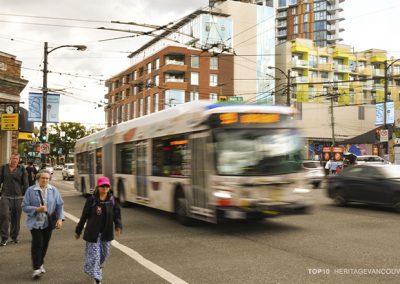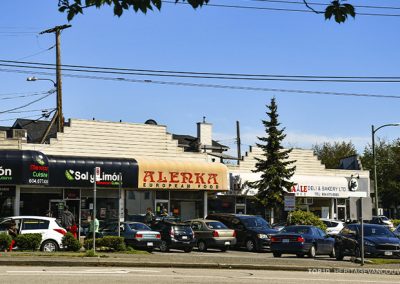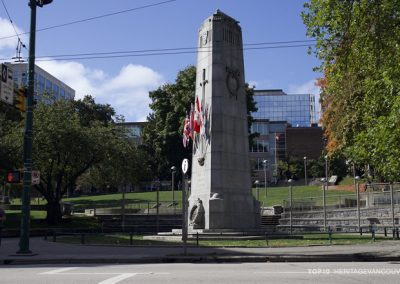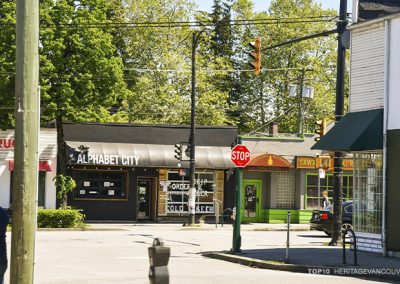The 800 block on Granville Street is located between Smithe and Robson Streets and is part of Vancouver’s Entertainment District. The 800 block used to be a vital component of Granville Street downtown, historically called Theatre Row, for decades the place to go to on Friday and Saturday nights for generations of people from all over the region to enjoy live music, dancing, bowling, and movies. As development is on its way, how can the cultural heritage of this place be conserved?
About
By the 1920s and 1930s, the focus of the heart of the city had shifted from the Downtown Eastside to Granville Street. One of the reasons for this shift was Vancouver’s new status as a destination for travelling vaudeville acts. Soon enough the movies (“talking pictures”) followed, and by the 1950s, neon lights generously lit up Granville Street. It had all started in the 1890s with the Vancouver Opera House – demolished for the Pacific Centre development, followed by Capitol Theatre (1921), the Commodore Ballroom (1929), Orpheum Theatre (1927) and Vogue Theatre (1941), to name a few. Add pool halls, arcades, bowling alleys and sex shops, and Theatre Row was ready to serve different generations of Vancouverites day and night.
Granville Street downtown and the 800 block in particular are generally considered historically and architecturally significant. However, what truly activates day and night life in this area, is what happens inside these buildings. The introduction of the home television set in the second half of the twentieth century took away much of the sparkle of Granville Street. In the 1990s, City Council initiated the Entertainment District by providing an easement on liquor licenses and allowing bars to stay open later than others: youth became the focus group of the area, and the number of police incidents have since increased annually. Theatre Row became Nightclub Row and the mix of generations previously attending Vancouver’s entertainment hub belonged to the past. On top of that came the COVID-19 pandemic, which badly affected local businesses and the arts & culture scene.
While still serving locals and tourists, the 800 block is now predominantly home to joints and clothing stores. One can visit Venue (previously Odeon and until 1997 the Plaza cinema/movie theatre) for live music and DJs. The Orpheum is home to the Vancouver Symphony Orchestra but also opens its doors for those interested in other genres. Bigger and smaller acts perform at the Commodore Ballroom. The facades of the Palms Hotel (1898) and Paradise Theatre (1938; previously Globe Theatre, 1913) are being retained as part of a new development; the 1987 modern architecture building that completed the Granville 7 Theatres complex (1987) has been demolished.
Why on the Top10?
“It’s time to see what we can do to bring Granville Street back as a destination, and for more than just one kind of nightlife goer. It’s time we look at what the future of Granville Street needs, acknowledging it still has a lot of time for yesterday. The street could be a much wider and varied attraction, and has tremendous potential.”
– Aaron Chapman, author and musician
Projects like The Rec Room at the Granville 7 Theatres complex and a development proposal for the east side of the 800 block attempt to bring new life into Granville Street.The Rec Room project includes an arcade, restaurants, a live performance venue and a rooftop patio. Bonnis Properties’ plans for the 800 block include the preservation and rehabilitation of the Commodore Ballroom and bowling lanes, the creation of a 7,800 sq ft performance space, the retention of four heritage facades (State Hotel, Clancy Building, Cameron Block, and the Service Building), and the introduction of over 400,000 sq ft of office space.
The proposals could bring day- and night-life to Granville Street, but will they also save the 800 block’s cultural heritage? Can these types of mix-use developments bring back a multi-generational audience to the area? How will new architecture blend in with built heritage? Which stakeholders and communities are engaged and served best by these changes? And how will the renewed focus on entertainment, together with new office space, connect to the many uses that Granville Street has, including restaurants/joints, social housing and shopping?
Granville Street downtown requires a comprehensive plan for the future, one that can be initiated through the Vancouver Plan. Community input will be critical for the retention of Granville Street’s cultural heritage, considering its historical, architectural, social and economic significance (including tourism). Consideration should be given to updating and clarifying the design guidelines (Granville Street Downtown South Guidelines) and Transfer of Density policies, as well as a study on the planning of new development in historic settings in terms of Granville Street’s architectural character. Altogether, an environment should be created in which the arts, culture and entertainment scenes on the 800 block of Granville Street can thrive, day and night.
Photo by Ben Geisberg
We acknowledge the financial assistance of the Province of British Columbia


